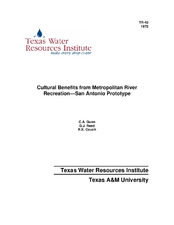| dc.description.abstract | This study analyzes the response to an outstanding design and development of a park-business complex along a natural river in the heart of a major city, The San Antonio River Walk. The research includes both those who visit and those who control or influence its development.
The River Walk refers to a horseshoe bend in the San Antonio River covering an area about four by six blocks in size in the central business district. This portion of the river lies in a deep cut, about 25 feet below street level, and is flanked by huge trees, lush plant growth and many shops, restaurants, and hotels. A continuous promenade parallels the river on both sides and the fifty-foot river is bridged many times providing both automobile and pedestrian crossing.
The research flowed along several lines in order to obtain full understanding of this unusual site. Because designed environments are seldom evaluated after construction, this project sought to obtain results on the following objectives:
1. to sketch the present trends in river development for recreation in U.S. cities,
2. to analyze the landscape character of the River Walk, and
3. to obtain the opinions and attitudes toward the use and characteristics of the River Walk from: a) the visitors at all seasons, b) the voters of San Antonio, c) the organizations and agencies controlling and influencing development, and d) the property owners contiguous to the River Walk.
To determine the status of urban river development in the U.S., a survey of the fifty largest cities was conducted in addition to a review of literature and visits to ten cities with urban water development. Data from these sources revealed the following:
There is at present very little use made of urban rivers and most have been badly abused. Many plans are being made in most cities for the realignment of policies governing their waterfronts. A few cities are beginning the implementation or redevelopment that incorporates the open space, esthetic and recreational values of their waters. | en |


